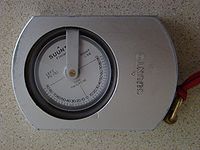AY Honors/Forestry/Answer Key
The clinometer, known in many fields as an inclinometer, is a common tool used in forestry to measure slope, vertical angles, and – in combination with distance measurements – elevation change or tree heights.
How it works
A forester using a clinometer makes use of basic trigonometry.
First the observer measures a straight-line distance D from some observation point O to the object. Then, using the clinometer, the observer measures the angle a between O and the top of the object. Then the observer does the same for the angle b between O and the bottom of the object. Multiplying D by the tangent of a gives the height of the object above the observer, and by the tangent of b the depth of the object below the observer. Adding the two of course gives the total height (H) of the object, in the same units as D.&
Note that since multiplication is distributive it is equally valid to add the tangents of the angles and then multiply them by D:
- A = tan a
- B = tan b
- H = (A × D) + (B × D) = (A + B) × D
Note also that both angles should be positive numbers (i.e. ignore any minus sign on the clinometer's scale).
Units of measure
There are typically three different units of measure that can be marked on a clinometer: degrees, percent, and topo. When buying a clinometer it is important to make sure it is calibrated to units suitable for the intended use.
Tree height measurement
The forester stands at a fixed distance from the base of the tree. The most common distances in the United States are Template:Convert, Template:Convert, and Template:Convert.& To obtain accurate readings it is best to use taped measured distance instead of paced distances. For the most accurate readings it is best to use a distance that is not less than the height of the tree being measured.&, that is, that the clinometer will measure an angle less than 45° (100%).
The observer sights to the top of tree, if total height is the desired measurement. If the desired measurement is merchantable height – that is, the height producing timber that can be sold – the observer sights to a point on the tree above which no more merchantable timber is found. The observer then measures to the bottom of the tree, takes the tangents and multiples them by the distance, and adds the two figures together. This will be the height of the tree.
The observer must always measure a leaning tree so that the tree is leaning to the left or right. Measurements should never be taken with the tree leaning toward or away from the observer because this will affect their accuracy because of foreshortening.
Slope measurement
The clinometer is also commonly used by foresters to obtain the percent slope of terrain. This measurement is based on the same trigonometric principles described above. Slope measurements, however, require that both observer and target be a constant height above the ground; thus a range pole or height of measurement (HI) stick is often used in slope measurements. Template:Commonscat Hey
See also
References
- ↑ Calvert, J.B. “The Clinometer.” 2003.
- ↑ Avery, T.E. and Burkhart, H.E. “Height Measurement Principles.” Forest Measurements 5th Edition. McGraw-Hill, 2002. 154.
- ↑ Williams, M.S., Bechtold, M.A., and V.J. LaBau. 1994 five instruments for measuring tree heights: an evaluation. Southern Journal of Applied Forestry 18: 76-82

